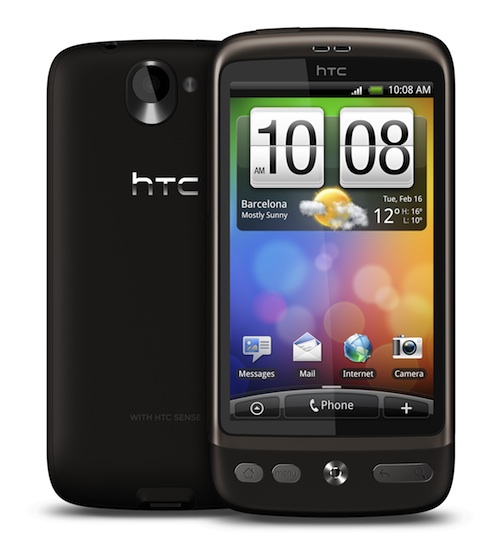By: Zachary Neal Wickeremasuriya
The Desire features a Qualcomm Snapdragon 1GHz processor, a large 3.7-inch AMOLED screen, five-megapixel camera with an LED flash, and 512mb of ROM, all of which are found in the Nexus One. And although HTC upped the ante a bit with 64mb more RAM over the Nexus One, it does lack a second microphone for noise cancellation. However, no one I talked to ever complained about poor clarity even in noisy places like shopping malls.
Also, the phone features four buttons below the screen, along with a clickable optical track pad, as compared to the trackball and touch-sensitive keys on the Nexus One.
Overall build quality is great. Weighing in at 135 grams with the battery installed, the phone feels slightly weighted which gives it a nice, well-built feel. The 3.7-inch display dominates the front of the phone, and the buttons below the display rest on a slight kink, also known as a “chin”. However, be warned that this gorgeous display does attract loads of fingerprints and smudges.
As for outputs, the phone features a basic micro-USB output, with a 3.5mm flush headphone jack at the top, which allows you to connect any headphones you like, a welcome feature, as the earphones which come with the phone simply would not fit properly, and even started to make my ears ache after barely five minutes of use. As with most stock earphones, the ones that come with the Desire are not fantastic. It does, however, feature a set of buttons to play or pause songs as well as answer calls, and two buttons to skip and rewind songs respectively. This remote also works as an antenna for the FM Radio.
The back of the phone has a matte finish, which feels slightly rubberised to the touch. I much preferred it to the glossy backs of some phones (like the iPhone), simply because it attracts no fingerprints or smudges, and seems pretty resilient against light scuffs and scratches.
The five-megapixel autofocus camera on the phone takes nice, sharp photos in daylight, and night exposures are decent. The camera features a wider angle of view than most phone cameras, with an aspect ratio of 5:3 compared to the Nexus One’s camera, which sports a 4:3 aspect ratio. Video is captured at a resolution of 800×480, and daytime videos generally look great, although moving the camera quickly or abruptly will cause a slight distortion in the video. Capturing videos at night is generally decent as well, although the frame rate at night does reduce quite a bit, which, unless you have very steady hands, will lead to a rather shaky and blurry video.
The Desire also features HTC Sense, a User Interface (UI) modification that sits on top of Android 2.1. It allows up to seven home screens, all customisable with a selection of widgets and program shortcuts. Friend Stream is a particularly useful widget for social networking junkies who want to keep up with Facebook and Twitter simultaneously.
However, the phone isn’t without its gripes. Firstly, there’s the battery life. HTC claims a maximum of 400 minutes of talktime, with a maximum of 360 hours of standby. In truth, the phone struggled to get anywhere near those targets during tests with the review set, and the battery barely lasted a full day. This hardly seems like a tall order since all I did was surf the web occasionally, watch one or two YouTube videos, sent a few texts and made a few phone calls.
The next gripe is the power button. It works great, but is also incredibly easy to press, which means the phone sometimes turned itself on while it was in my jeans pocket as I sat down. Also, none of the four buttons on the front, the clickable optical track pad nor the volume control buttons could be used to activate the display, which might not sound like a big deal, but it complicated things when I wanted to check if it was off or on.
The nitpicking aside though, it is a great mobile phone. It’s well built, takes reasonably good photos and videos, features a great UI, surfs the web smoothly and effortlessly and offers Flash support (which the iPhone will never do, sadly.)
If only it lasted long enough for me to enjoy it even more.
The pros:
• Great 3.7” AMOLED display
• Good build quality and design
• Fast, smooth web browsing
• HTC Sense looks a lot nicer than the Android 2.1 UI
The cons:
• Lacklustre battery life
• Earphones just don’t fit
• Android market still far less impressive than the Apple App Store

